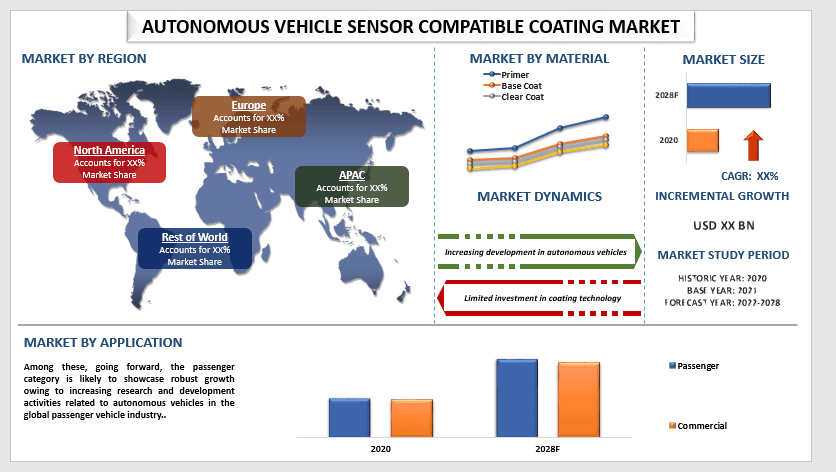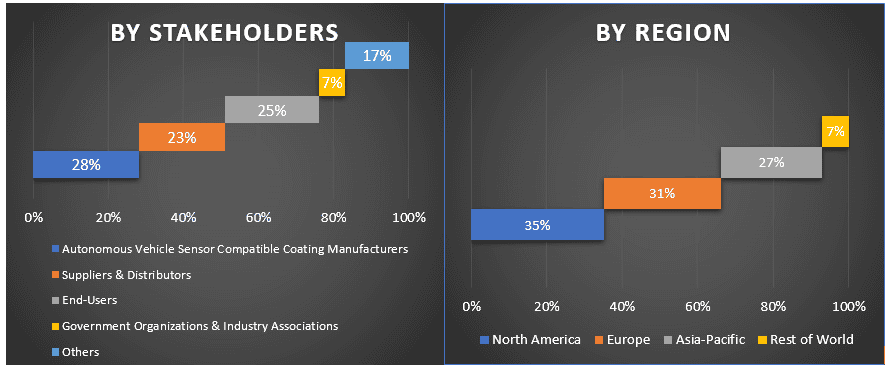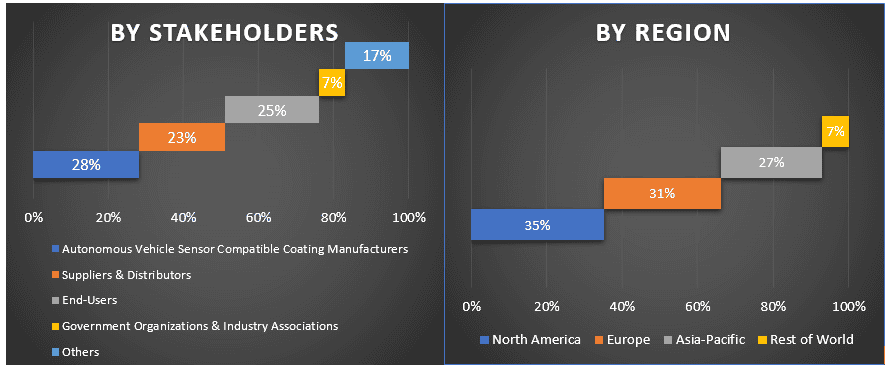
The global autonomous vehicle sensor compatible coating market is likely to showcase robust growth during the forecast period. Paints and coatings play a crucial role in the automobile industry by providing safety against corrosion and other unfavorable conditions while simultaneously providing an aesthetic look. However, increasing development in autonomous vehicles is changing the role of conventional suppliers. Paints and coating manufacturers are also increasingly investing in the research and development of coatings that can meet the requirement of autonomous vehicles. The sensor is among the crucial component of autonomous vehicles therefore their proper functioning can not be compromised. As a result, paints and coating manufacturers are developing self-cleaning coatings. Currently, the industry is at its initial stage, however, as the global investment toward autonomous vehicle grows, the demand for sensor-compatible coating will grow eventually.
Insights Presented in the Report
“Amongst type, clear coat is likely to showcase robust growth ”
Based on type, the market is categorized into the primer, base coat, clear coat, and others. Among these, the clear coat is likely to showcase significant growth over the forecast period. This can be mainly ascribed to the fact that clear coat is the top most coat in the automotive which plays a key role in removing dirt from the sensors, thus it is expected that both automobile and paints and coatings manufacturers would focus more on clear coat category.
“Amongst vehicle, passenger category held a prominent position in the market in 2020”
Based on vehicle type, the market is categorized into passenger and commercial. Among both, going forward, the passenger category is likely to showcase robust growth owing to increasing research and development activities related to autonomous vehicles in the global passenger vehicle industry. Further, several Level 1 and Level 2 passenger vehicles are already in the market which is fueling the passenger segment.
“North America is likely to showcase significant growth during the forecast period”
For a better understanding of the market adoption of autonomous vehicle sensor compatible coating, the market is analyzed based on its worldwide presence in the countries such as North America (the United States, Canada, Rest of North America), Europe (Germany, the United Kingdom, France, Italy, Spain, and Rest of Europe), Asia-Pacific (China, Japan, India, and Rest of Asia-Pacific), and Rest of World. North America is expected to showcase robust growth over the forecast period owing to the presence of major automobile players in the region who are continuously focusing on the development of advanced autonomous vehicles. For instance, Tesla offered autopilot features in its vehicle which is classified as Level 2 under the SAE six levels (0 to 5) of vehicle automation. At this level, the car can act autonomously, but requires the driver to monitor the driving at all times and be prepared to take control at a moment’s notice.
Reasons to buy this report:
Customization Options:
The global autonomous vehicle sensor compatible coating market can further be customized as per the requirement or any other market segment. Besides this, UMI understands that you may have your own business needs, hence feel free to connect with us to get a report that completely suits your requirements.
1. Market Introduction
2. Research Methodology Or Assumption
3. Market Synopsis
4. Executive Summary
5. Impact Of Covid-19 On The Autonomous Vehicle Sensor Compatible Coating Market
6. Autonomous Vehicle Sensor Compatible Coating Market Revenue (usd Mn), 2020-2028f
7. Market Insights By Type
8. Market Insights By Vehicle Type
9. Market Insights By Region
10. Autonomous Vehicle Sensor Compatible Coating Market Dynamics
11. Autonomous Vehicle Sensor Compatible Coating Market Opportunities
12. Autonomous Vehicle Sensor Compatible Coating Market Trends
13. Demand And Supply-side Analysis
14. Value Chain Analysis
15. Competitive Scenario
16. Company Profiled
17. Disclaimer
Research Methodology for Global Autonomous Vehicle Sensor Compatible Coating Market Analysis (2020-2028)
Analyzing the historical market, estimating the current market, and forecasting the future market of autonomous vehicle sensor compatible coating, three major steps are undertaken to create and analyze its adoption across the globe. Exhaustive secondary research was conducted to collect the historical market numbers and estimate the current market size. Secondly, to validate these insights, numerous findings and assumptions were taken into consideration. Moreover, exhaustive primary interviews were also conducted, with industry experts across the value chain of the industry. Post assumption and validation of market numbers through primary interviews, we employed a bottom-up approach to forecast the complete market size. Thereafter, market breakdown and data triangulation methods were adopted to estimate and analyze the market size of segments and sub-segments of the industry pertains to. Detailed methodology is explained below:
Analysis of Historical Market Size
Step 1: In-Depth Study of Secondary Sources:
Detail secondary study was conducted to obtain the historical market size of autonomous vehicle sensor compatible coating through company internal sources such as annual reports & financial statements, performance presentations, press releases, etc., and external sources including journals, news & articles, government publications, competitor publications, sector reports, third-party database, and other credible publications.
Step 2: Market Segmentation:
After obtaining the historical market size of the autonomous vehicle sensor compatible coating market, we conducted a detailed secondary analysis to gather current market insights and share for different segments & sub-segments for major regions. The major segment is included in the report by type and vehicle type. Further regional and country-level analyses were conducted to evaluate the overall adoption of Autonomous Vehicle Sensor Compatible Coating globally.
Step 3: Factor Analysis:
After acquiring the historical market size of different segments and sub-segments, we conducted a detailed factor analysis to estimate the current market size of Autonomous Vehicle Sensor Compatible Coating. Further, we conducted factor analysis using dependent and independent variables such as the increasing development in the autonomous vehicles sector and the growing usage of sensors in automobiles. A thorough analysis was conducted of demand and supply-side scenarios considering the increasing investment, top partnerships, mergers and acquisitions, business expansion, and product launches in the autonomous vehicle sensor compatible coating industry.
Current Market Size Estimate & Forecast
Current Market Sizing: Based on actionable insights from the above 3 steps, we arrived at the current market size, key players in the global market, and market shares of each segment. All the required percentage shares split, and market breakdowns were determined using the above-mentioned secondary approach and were verified through primary interviews.
Estimation & Forecasting: For market estimation and forecast, weights were assigned to different factors including drivers & trends, restraints, and opportunities available for the stakeholders. After analyzing these factors, relevant forecasting techniques i.e., the bottom-up approach were applied to arrive at the market forecast for 2028 for different segments and subsegments across the major regions globally. The research methodology adopted to estimate the market size encompasses:
Market Size and Share Validation
Primary Research: In-depth interviews were conducted with the Key Opinion Leaders (KOLs) including Top Level Executives (CXO/VPs, Sales Head, Marketing Head, Operational Head, Regional Head, Country Head, etc.) across major regions. Primary research findings were then summarized, and statistical analysis was performed to prove the stated hypothesis. Inputs from primary research were consolidated with secondary findings, hence turning information into actionable insights.
Split of Primary Participants by Stakeholders and Regions

Market Engineering
The data triangulation technique was employed to complete the overall market estimation and to arrive at precise statistical numbers for each segment and sub-segment of the global autonomous vehicle sensor compatible coating market. Data was split into several segments & sub-segments post studying various parameters and trends in the area of type and vehicle type.
The main objective of the autonomous vehicle sensor compatible coating market study
The current & future market trends of global autonomous vehicle sensor compatible coating were pinpointed in the study. Investors can gain strategic insights to base their discretion for investments on the qualitative and quantitative analysis performed in the study. Current and future market trends would determine the overall attractiveness of the market at a country level, providing a platform for the industrial participant to exploit the untapped market to benefit as a first-mover advantage. Other quantitative goals of the studies include:
Deep dive country-level analysis of the industry

Customers who bought this item also bought